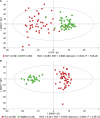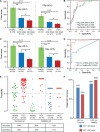Comparison of hepatic and serum lipid signatures in hepatocellular carcinoma patients leads to the discovery of diagnostic and prognostic biomarkers
- PMID: 29435160
- PMCID: PMC5797031
- DOI: 10.18632/oncotarget.23494
Comparison of hepatic and serum lipid signatures in hepatocellular carcinoma patients leads to the discovery of diagnostic and prognostic biomarkers
Abstract
We compared hepatic and serum lipid changes in hepatocellular carcinoma (HCC) patients to have a better understanding of the molecular pathogenesis of this disease and discovery novel lipid biomarkers. Hepatic and serum lipid profiling was conducted in paired liver and serum samples from 50 HCC patients and 24 healthy controls. A total of 20 hepatic and 40 serum lipid signatures were identified, yet there was hardly any significant correlation between them. The results indicated that triglycerides and phosphatidylcholines contributed significantly to altered hepatic lipids, whereas triglycerides and phosphatidylethanolamine-based plasmalogens (PEp) contributed most to altered serum lipids. In serum, PEp (36:4) and (40:6) showed a fair capability to discriminate HCC patients from healthy controls, and were significantly associated with HCC tumor grades (p < 0.05), and thus were identified as potential diagnostic and prognostic biomarkers of HCC. These findings were confirmed by a validation study conducted in an independent cohort consisting of 18 HCC, 20 cirrhosis patients, and 20 healthy controls. This study suggests that hepatic and serum lipid signatures of HCC have to be considered as mostly independent, and the results imply potential roles of PEp species, particularly PEp (36:4) and (40:6), as serum biomarkers for HCC diagnosis and progression.
Keywords: hepatocellular carcinoma; lipidomics; liver tissue; mass spectrometry; serum.
Conflict of interest statement
CONFLICTS OF INTEREST The authors have no conflicts of interest to declare.
Figures


References
-
- Okabe H, Satoh S, Kato T, Kitahara O, Yanagawa R, Yamaoka Y, Tsunoda T, Furukawa Y, Nakamura Y. Genome-wide analysis of gene expression in human hepatocellular carcinomas using cDNA microarray: identification of genes involved in viral carcinogenesis and tumor progression. Cancer Res. 2001;61:2129–2137. - PubMed
-
- Tran PL, Vigneron JP, Pericat D, Dubois S, Cazals D, Hervy M, DeClerck YA, Degott C, Auclair C. Gene therapy for hepatocellular carcinoma using non-viral vectors composed of bis guanidinium-tren-cholesterol and plasmids encoding the tissue inhibitors of metalloproteinases TIMP-2 and TIMP-3. Cancer Gene Ther. 2003;10:435–444. - PubMed
-
- El-Aneed A, Banoub J. Proteomics in the diagnosis of hepatocellular carcinoma: focus on high risk hepatitis B and C patients. Anticancer Res. 2006;26:3293–3300. - PubMed
-
- Lee NP, Cheung ST, Poon RT, Fan ST, Luk JM. Genomic and proteomic biomarkers for diagnosis and prognosis of hepatocellular carcinoma. Biomark Med. 2007;1:273–284. - PubMed
-
- Khattab MA, Eslam M, Mousa YI, Ela-adawy N, Fathy S, Shatat M, Abd-Aalhalim H, Kamal A, Sharawe MA. Association between metabolic abnormalities and hepatitis C-related hepatocellular carcinoma. Ann Hepatol. 2012;11:487–494. - PubMed
LinkOut - more resources
Full Text Sources
Other Literature Sources
Miscellaneous

